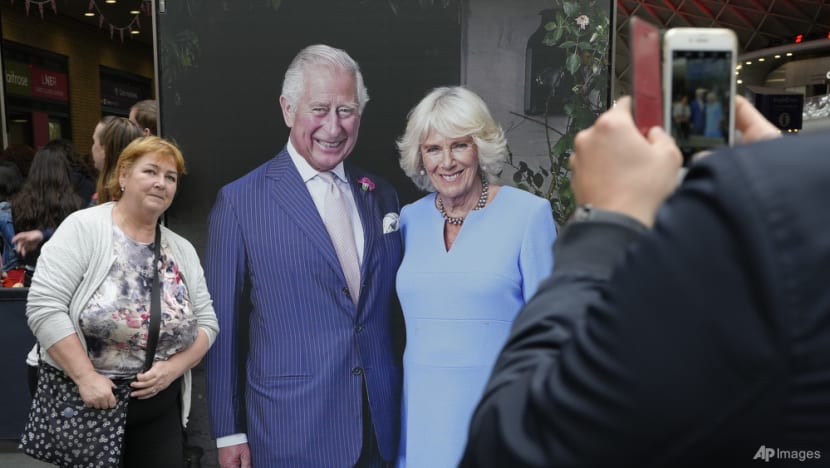Commentary: Accession of King Charles, a divorcee, would once have scandalised. But much has changed
As a divorced and remarried monarch, King Charles III represents the reinvention of the British monarchy, which seeks to embrace its role in a more open and tolerant society, says this Macquarie University academic.

A tourist poses for a picture alongside a large portrait of Britain's King Charles III and Camilla, Queen Consort, in London, May 1, 2023. (AP Photo/Kirsty Wigglesworth)
SYDNEY: King Charles III is the first British monarch who has previously had a civil marriage and a civil divorce.
In 1981, Charles, then the Prince of Wales, married Lady Diana Spencer in a fairytale wedding watched by 750 million people worldwide.
However, the royal couple separated in 1992 and they were divorced in 1996. The marriage had spectacularly broken down.
Charles later went on to marry his long-time love interest Camilla Parker-Bowles. They married in a civil ceremony in 2005. This broke with the tradition of royal family members getting married in an Anglican church ceremony.
The extramarital relationship of Charles and Camilla prevented them from being remarried in church. But there was a subsequent service of prayer and dedication. Queen Elizabeth II declined to attend the wedding, reportedly because it conflicted with her role to uphold the Christian faith as supreme governor of the Church of England.
The accession of Charles to the throne is not only politically significant, but also carries religious importance. Charles is the “defender of the faith” and the supreme governor. Charles’ status as a divorcee puts him at odds with his religious roles.
ROYAL DIVORCES
King Henry VIII was infamous for having six wives in the 16th century. He annulled his first marriage to Catherine of Aragon. This meant the marriage was never legally valid to begin with.
King George IV was almost successful in divorcing his wife Queen Caroline in 1820. At the time, divorce could only be granted by Act of Parliament. The trial took place in the House of Lords. The king accused his wife of committing adultery as grounds for divorce. However, Prime Minister Lord Liverpool eventually withdrew the divorce bill due to political pressure.
King Edward VIII was forced to abdicate in 1936 because he wanted to marry an American divorcee Wallis Simpson. This conflicted with his role as supreme governor.
While Charles was in a similar position to his great-uncle in his marriage to Camilla, they lived in different worlds. The Conservative government and the Church of England simply could not tolerate Edward’s marriage to a divorcee. It was viewed as an affront to morality.
Similarly, Princess Margaret was pressured to not marry the divorcee Group Captain Peter Townsend. As the sister of the queen, the marriage would have been scandalous in some circles.
Queen Elizabeth called 1992 the “annus horribilis” (horrible year) for the royal family. Her three children Prince Charles, Princess Anne and Prince Andrew’s marriages had all broken down. Divorce by then had become increasingly acceptable in society.ROYAL CIVIL MARRIAGE
Charles had to seek his mother’s permission to marry Camilla. The Royal Marriages Act 1772 stipulated that all descendants of King George II were required to seek the consent of the sovereign to marry.
This law was repealed in 2013. Only the first six persons in the line of succession now have to seek the sovereign’s permission to marry.
There was controversy at the time whether a member of the royal family could legally marry in a civil ceremony. The Marriage Act 1836 permitted civil marriages. But the law stated this did not apply to members of the royal family.
The British government released a statement declaring Charles could legally enter into a civil marriage. The view was the Marriage Act 1949 had repealed the previous legislation. The government also argued there was a right to marry under the Human Rights Act 1998 and the European Convention on Human Rights.
The civil marriage of Charles and Camilla symbolised the changing values of society. The view of marriage had shifted from a moral commitment to a celebratory union. This marked the modernisation of the monarchy over tradition.
A MODERN MONARCHY
The accession of a divorcee as king a generation earlier would have been unpalatable to many. But Charles embodies the modern character of monarchy and the liberal values of wider society.
Charles has recently affirmed his commitment to Anglican Christianity. This is an acknowledgement of his constitutional role in the Act of Settlement 1701. Only Protestant Christians can claim succession to the crown.
It also affirms his role as nominal ruler of the Church of England. The monarch still appoints bishops on the advice of the prime minister. Anglicanism is the official state religion of England.
Yet Charles is also pushing for a modern monarchy. He has viewed himself as a defender of diversity. Upholding a space for multifaith practice and expression of secular ideals form part of the agenda of his reign.
The monarchy faces a tension between modernity and tradition. As a divorced and remarried monarch, Charles III represents the reinvention of the crown, an ancient institution that seeks to embrace its role in a multicultural, religiously diverse and more open and tolerant society.
Henry Kha is Senior Lecturer in Law at Macquarie University. This commentary first appeared on The Conversation.















